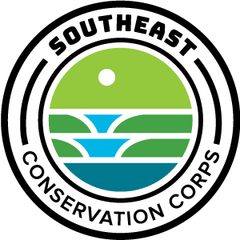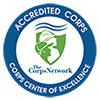This is Your Captain Speaking
BlogJune 7, 2021 | PART 1: A NOTE FROM YOUR CAPTAIN...
Spanish moss hangs from healthy young oak trees above eight tents near Fort Frederica National Monument on St. Simon’s Island, GA. The sounds of cooking drift from an open-air garage beside a small, modest, mid-century house, and a few colorful camp chairs form a semicircle in the driveway. Laughter mingles with the smells of coconut, simmering vegetables, curry, and warm rice, as the sky glows a soft, dim, evening blue. Insects flutter, some lazily, some with the frenetic energy that powers only the tiniest of creatures, and the shrill, consistent hum of cicadas echoes from high above. Just north of here, historic Fort Frederica looms beside the shifting water of the Mackay River, which winds down around the south end of the island and spills into the Atlantic Ocean.
We’re SECC’s Urban Archaeology Adult Crew, first of our name, and discoverers of buried treasure (trash). I write from the tail-end of our first exhilarating week out here on the island, which felt pleasantly stretched, accordion-like, into something more like a month.
We set out on Tuesday, June 1, just in time to hit every major town and city’s post-Memorial Day traffic, turning a 6.5 hour drive into a 10 hour one. Potentially a loathsome inconvenience, the extended journey only gave our crew more time to enjoy getting to know each other by sharing our favorite musical artists and learning each other’s personal histories. Despite a late arrival, we were greeted warmly by park volunteers upon entering the Fort Frederica National Monument grounds. We set up tents and an outdoor kitchen and settled in for a hearty, homemade coconut curry dinner before heading to bed, excited for our first day of work in the morning.

The week that followed was a brilliant blur. In the morning, we met archaeologist Michael Seibert, our project partner, who introduced us to the types of artifacts we’d be finding at the dig site by starting us off in the lab. We sorted shards of pottery, some small, some quite large, as well as bits of porcelain, pearlware, stoneware, and metal nails, among other items. All had been found at the site purported to be the home of one Archibald Sinclair, an indentured servant living at Fort Frederica around the time the colony was first established in the mid-18th century. If you’ve never done it, I promise it is fascinating to hold the pieces of cups, plates, tools, and otherwise common objects used by people who lived almost 300 years ago.
On our second day, we got our first taste of dirt. Michael showed us how to open up two new 1mx1m units, plotted in a grid underneath a righteous tent protecting us from the Georgia sun (but not the Georgia humidity). We shoveled earth, ripped and clipped roots, and cleared off the top layer of grassy sod for each unit, revealing dark, silty dirt underneath. Then the real work began: we grabbed towels and knelt down on hands and knees to slowly and evenly scrape away centimeter after centimeter of soil, working steadily downwards in-depth and backward through time.
Over the next couple of days, we continued working downward, stopping every ten centimeters to level off and photograph the unit, making sure to capture any soil color changes or other anomalies. We unearthed rusted barbed wire, 300-year-old bricks, bullets and bullet casings, shards of pots, cups, and plates, and of course, lots and lots of oyster shells (pretty, but not very archaeologically exciting on an island basically made of oyster shells).

As a lover and student of archaeology, among a crew of anthropology, biology, and history students (both in school and post-graduate), I’ve found myself swept into the tactile, satisfying, curious work of digging through historic trash. What’s more, we all have been swept into the joyful work of getting to know each other, and have grown to be an honest, communicative, and outrageously funny family in just one week.
Our discussions as a group about the indigenous population of the island have revealed how little is known about the sea islands before colonization. Hopefully, next month we’ll learn more, as we will be working at a Native American midden site on Cumberland Island. Until then, ahoy!
-Captain Peg Leg (Crew Leader Anna Dottle)
PS. If you are running joyously to the edge of the ocean on your day off, remember that water is fluid, and the ground is not always where you think it is. Trust me and my heavily sprained ankle.
PART 2: AND A WORD FROM SAM...
Hello, hello! It’s me, Sam, writing from the site of Ft. Frederica at St. Simon’s Island off the coast of Georgia. We’re settling quite nicely in our little campsite, considering the onslaught of ticks and dealing with leaking tents. We’ve so far done an amazing amount of work at the Sinclair Archaeological Site finding a slew of artifacts in just a few first layers. This past weekend, we had a wonderful breather at the beach for the day which ended with us quickly packing our stuff up as the fast-approaching high tide rose out of nowhere. Though a few of us got a sunburn (like me, despite the 100 SPFSunscreen), Anna sprained her ankle, and some of our stuff got wet (including my battery pack which is now sadly kaput, we still managed to have fun and relaxing time.
I was a little nervous (by which I mean a lot) coming into this program since I’ve never done anything like this before, let alone for an extended period of time. But the experience so far has been pleasantly surprising, even for myself. Everyone in the crew is so open and kind, I’ve never been amongst a newly acquainted group before that hit it off straight from the get-go. It really made it easy for an extremely anxious introvert like myself to relax and open up quicker than usual. And so far I’ve exceeded my expectations, pitching my tent mostly solo and cooking dishes for everyone on a whim -- even prepping an entire breakfast-dinner spread by my lonesome the other night. Just like how I look forward to seeing what other wonders lay within the depths of the dig site, I too am excited to dig deeper into learning more about the extraordinary friends I’m working with and seeing what makes them the cool (and crazy/weird) people they are, while giving them the opportunity to do the same in getting to know the out-there person I am.
Anna Dottle and Sam Kreps
Crew #981





